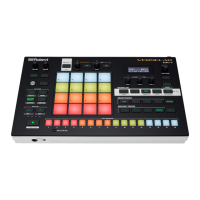18
MFX Parameters
06 Step Filter
This is a lter whose cuto frequency can be modulated in steps. You
can specify the pattern by which the cuto frequency will change.
L in L out
R outR in
Parameter Value Explanation
Step 01–16 0–127 Cuto frequency at each step
Rate
(sync sw) OFF, ON
If this is ON, the rate synchronizes with the tempo
of the rhythm.
Rate (Hz) 0.05–10.00 [Hz]
Frequency of modulation
Rate
(note)
Note
&
“Note” (p. 51)
Attack 0–127
Speed at which the cuto frequency changes
between steps
Filter Type LPF, BPF, HPF, NOTCH
Type of lter
Frequency range that will pass through each
lter
LPF: frequencies below the cuto
BPF: frequencies in the region of the cuto
HPF: frequencies above the cuto
NOTCH: frequencies other than the region of
the cuto
Filter Slope -12, -24, -36 dB
Amount of attenuation per octave
-12 dB: Gentle, -24 dB: Steep, -36 dB:
Extremely steep
Filter Resonance 0–127
Filter resonance level
Increasing this value will emphasize the
region near the cuto frequency.
Filter Gain 0–+12 [dB] Amount of boost for the lter output
Level 0–127 Output Level
07 Enhancer
Controls the overtone structure of the high frequencies, adding sparkle
and tightness to the sound.
L in L out
R outR in
Mix
Mix
Parameter Value Explanation
Sens 0–127 Sensitivity of the enhancer
Mix 0–127
Level of the overtones generated by the
enhancer
Low Gain -15–+15 [dB] Gain of the low range
High Gain -15–+15 [dB] Gain of the high range
Level 0–127 Output Level
08 Auto Wah
Cyclically controls a lter to create cyclic change in timbre.
L in L out
R outR in
Parameter Value Explanation
Filter Type LPF, BPF
Type of lter
LPF: Produces a wah eect in a broad
frequency range.
BPF: Produces a wah eect in a narrow
frequency range.
Manual 0–127
Center frequency at which the wah eect is
applied
Peak 0–127
Width of the frequency region at which the
wah eect is applied
Increasing this value will make the frequency
region narrower.
Sens 0–127
Adjusts the sensitivity with which the lter is
controlled.
Polarity UP, DOWN
Direction in which the lter will move
UP: The lter will change toward a higher
frequency.
DOWN: The lter will change toward a lower
frequency.
Rate
(sync sw) OFF, ON
If this is ON, the rate synchronizes with the
tempo of the rhythm.
Rate
(Hz) 0.05–10.00 [Hz]
Modulation frequency of the wah eect
Rate
(note)
Note
&
“Note” (p. 51)
Depth 0–127 Depth of modulation
Phase 0–180 [deg]
Adjusts the degree of phase shift of the left
and right sounds when the wah eect is
applied.
Low Gain -15–+15 [dB] Gain of the low range
High Gain -15–+15 [dB] Gain of the high range
Level 0–127 Output Level

